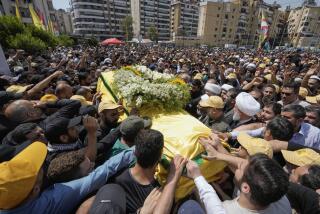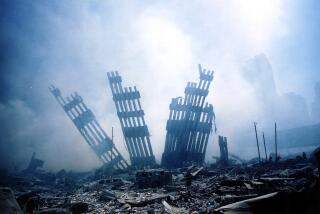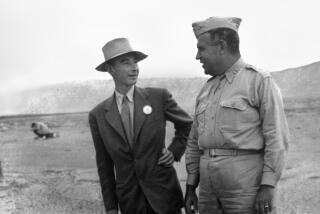West Germans Faulted : Pan Am 103 Probe: Was It Bungled?
WASHINGTON — U.S. intelligence officials were more than a little surprised last October when West German police released at least 12 radical Palestinians who had been arrested in connection with possessing highly sophisticated bombs.
But the Germans protested that they lacked evidence to hold the radicals, who were members of the Popular Front for the Liberation of Palestine-General Command. Most had been in custody less than 24 hours.
Now, U.S. officials believe those same Palestinians went on to orchestrate the bombing of Pan Am Flight 103 (originating in Frankfurt, West Germany) last Dec 21. Their search for the bombers, which has reached from Finland to Japan, from Shiite Muslim neighborhoods of Lebanon to the suburbs of Detroit, is now focusing on the Palestinian radicals.
Unmatched Intensity
“I can’t think of any (manhunt) that would match it in terms of breadth of coverage or certainly have been more intensive,” said Oliver B. Revell, the FBI executive assistant director in overall charge of the probe.
U.S. officials believe as many as six of the radicals have disappeared into Syria, but they are uncertain where the others are. And they concede that they do not have a good enough case against them to indict anyone.
But U.S. intelligence authorities are now convinced that the radicals are part of a terrorism conglomerate that was responsible for the bombing. They believe that an Iranian Revolutionary Guard faction probably commissioned the crime, the PFLP-GC carried it out, and a defunct Palestinian splinter group called the Arab Organization of May 15 provided the bomb technology.
Despite that progress, officials are no closer to determining who actually placed the bomb on Flight 103. But investigators in Scotland have determined that the Boeing 747 was brought down with Semtex, a sophisticated plastic explosive, secreted inside a combination radio and cassette player.
Bungling Charged
Whatever has been learned, American intelligence and counterterrorism sources give no thanks to the West Germans. American agents charge that their German counterparts have bungled the job and may be further hindering the probe by engaging in a cover-up of their errors.
“The German behavior has been scandalous,” a U.S. counterterrorism source said. “At every turn, they have blocked us and prevented us from getting access to crucial data.”
U.S. officials are particularly outraged that the Germans lost track of the Palestinian radicals after releasing them in October. Not until after Flight 103 exploded over Lockerbie, Scotland, killing all 259 persons on board and 11 on the ground, did West German authorities realize the possible scope of the group’s activities.
Even after that, according to U.S. officials, the Germans botched the job. Last month, a Middle East informant told U.S. officials that the Germans had not found all the PFLP-General Command’s bombs left in a safehouse near Duesseldorf that police raided last October when they arrested the 12 radicals.
Only when pressed by the Americans did the Germans return to the house, where they found two radio-cassette players and a computer monitor. But they still did not believe the Americans. At one point, they dumped the electronics on the desk of the German criminal police director.
“They indeed did not think they were dealing with a bomb,” Revell said.
2 Bomb Experts Killed
They finally became convinced only when explosives hidden inside the computer monitor exploded, killing the two bomb experts who were disassembling it.
To complicate matters, the Germans then intentionally detonated the explosives inside one of the radio-cassette players before U.S. officials had a chance to examine it. Although enough was left of the bombs to determine that they contained Semtex, other vital data was lost.
Bush Administration sources now theorize that among the 12 Palestinians was a German informant the German government was trying to protect. After the Pan Am bombing, the Germans realized that their informant may have been acting as a double agent or, at minimum, deceiving them.
Since then, the current theory goes, the Germans have been engaged in a partial cover-up to prevent disclosure of their error.
“It’s the only explanation,” said a U.S. official. “The Germans are not ordinarily so inefficient or so sloppy.”
The uncharacteristic German inefficiency may simply reflect the inexperience of the unit of the BKA, roughly a federal police counterpart of the FBI, that is conducting the probe. It was created only last June, according to the FBI.
Atty. Gen. Dick Thornburgh discussed U.S. concerns this week with German officials attending an international terrorism conference in Madrid. “A lot of people are concerned,” a Bush Administration source said.
The U.S. side of the investigation is on two tracks. The FBI, cooperating with British agencies, is collecting forensic evidence, largely from the scene of the crime. Several agencies--sources identified them as the CIA, FBI and National Security Agency--are also conducting a separate intelligence operation.
It is the intelligence operation that has identified the dozen Palestinian radicals from the PFLP-GC as the likely perpetrators.
“The CIA is convinced it has a lock on who did it, while the FBI says there is not enough proof to stand up in court or to warrant any retaliation,” a counterterrorism official said. He said the CIA case appears lightweight. “The CIA believe they have a lot, but it’s a Styrofoam brick,” he said.
So certain were CIA officials last month that they briefed President Bush and National Security Council officials. They favored making the information public, but other intelligence officials held them back.
The forensic operation is more meticulous and painstaking. In Scotland, investigators are still examining the debris that the bombing left scattered over the Scottish countryside. Apart from the Boeing 747’s cockpit and tail, said Neil Gallagher, chief of the FBI’s counterterrorism unit, “you could pick up any portion of what remains in your hands.”
Revell said investigators found “one large packet of money, a substantial amount,” along with “jewelry and other negotiables.”
“When you’re looking at an aircraft that size, you always get into things like smuggling and so forth,” Revell said. “When you have 259 people, there are going to be things to be followed up that are not going to be central to the cause of the crash.”
Investigators in Scotland scored a breakthrough when they identified the “igloo,” or baggage container, that carried the explosive. That piece of forensic work alone reduced the number of passengers who may have carried the bomb to the plane to fewer than 100, according to Gallagher.
But investigators have still not identified the individual. They suspect--but are not sure--that the bomb was brought to the plane by a passenger who had no idea he was carrying the death certificate for himself and the other 258 people aboard.
“We still do not know how and who brought it (the hidden bomb) onto the plane,” said Gallagher.
That side of the manhunt has included checking out thousands of leads, not all involving people on board Flight 103.
One was a Lufthansa stewardess with a Middle Eastern boyfriend. Although she was not on the flight, she put a bag or parcel on board Flight 103. She was eventually cleared.
Another was an Iranian passenger who flew on Flight 103 from Frankfurt aboard a smaller Boeing 727 but disembarked in London, where the flight switched to the jumbo jet. Investigators are still examining the possibility that this passenger, who has not been traced yet, left luggage on board for transfer to the London-New York leg of the flight.
Khalid Jaafar, a Lebanese Shiite Muslim who was returning to his family in Dearborn, Mich., from a trip to West Germany, was once at the top of the list of those believed likely to have carried the bomb that was loaded aboard Flight 103. But he is no longer considered the principal suspect.
The American-Arab Anti-Discrimination Committee “would like us to exonerate him,” Revell said. “We can’t, but we also have no reason at this point to incorporate him into the case except that he was in Germany, was from Lebanon and obviously would come into contact with people in that community.”
The investigation stretched to Finland, where investigators tracked down what turned out to be a bogus threat to attack a Pan Am plane flying out of Europe at about the time of the Flight 103 bombing.
And it also reached Japan, where FBI agents talked with officials of Toshiba, the manufacturer of the radio-cassette player that was found in the PFLP-GC safehouse and the one that was believed to have carried the Pan Am bomb.
The agents checked various models to determine whether any might have been able to contain the bomb. Equally important, they interviewed Toshiba about where it sells certain models to help determine where the radios might have been bought--and by whom.
Investigators are also trying to identify and trace the piece of luggage that carried the deadly radio-cassette player.
Agents interviewed baggage manufacturers to determine, as Revell explained, “how many items were manufactured, where were they sold, were they part of a product line in a particular area that was not available elsewhere, was it used by businesses as issue to their employees?”
Just as the intelligence operatives are more convinced than the forensic detectives that the Palestinian radicals from the PFLP-GC orchestrated the bombing, so are they more confident that Iran conceived the crime.
U.S. intelligence authorities, drawing on highly classified information collected since January, believe that an Iranian Revolutionary Guard faction was the bombing’s prime instigator. Since 1982, the Revolutionary Guards have maintained bases near PFLP-GC strongholds in Lebanon’s Bekaa Valley, where the two hard-line Middle East groups meet regularly.
PFLP-GC leader Ahmed Jibril has been to Iran at least once since last fall. The Palestinian splinter group has collaborated with Tehran in past terrorist attacks and played a minor role in the 1983 bombing of the U.S. Marine barracks in Lebanon, according to U.S. counterterrorism specialists.
FBI officials remain less than certain. “We can’t state that the PFLP-GC was responsible,” Gallagher said. “A promising theory, but until I see the evidence connected with it, it remains a theory.”
A third issue is the role of former members of the defunct terrorist group known as May 15.
The bomb carried a “trademark” tied to Abu Ibrahim, the legendary master bomb maker of that group, who is now reportedly crippled and retired in Baghdad, Iraq, counterterrorism sources said. Although intelligence sources doubt Abu Ibrahim’s direct involvement, they suspect that the men who constructed the sophisticated plastique Pan Am bomb were his students or proteges.
“Few people have the ability to construct a bomb of such sophistication,” a counterterrorism official said. “Someone trained by May 15 made the bomb.”
The combination of forces underscores two increasing trends in terrorism in the 1980s:
First, the largest terrorist operations often bring together diverse and politically disparate groups to accomplish a common end. Second, new terrorism technology spreads widely--and often too quickly for investigators to keep up.
“It would be a significant and unusual breakthrough if we solve this case,” a leading Bush Administration terrorism official said. “At the same time, we are further along on this case than any other.”
More to Read
Sign up for Essential California
The most important California stories and recommendations in your inbox every morning.
You may occasionally receive promotional content from the Los Angeles Times.










